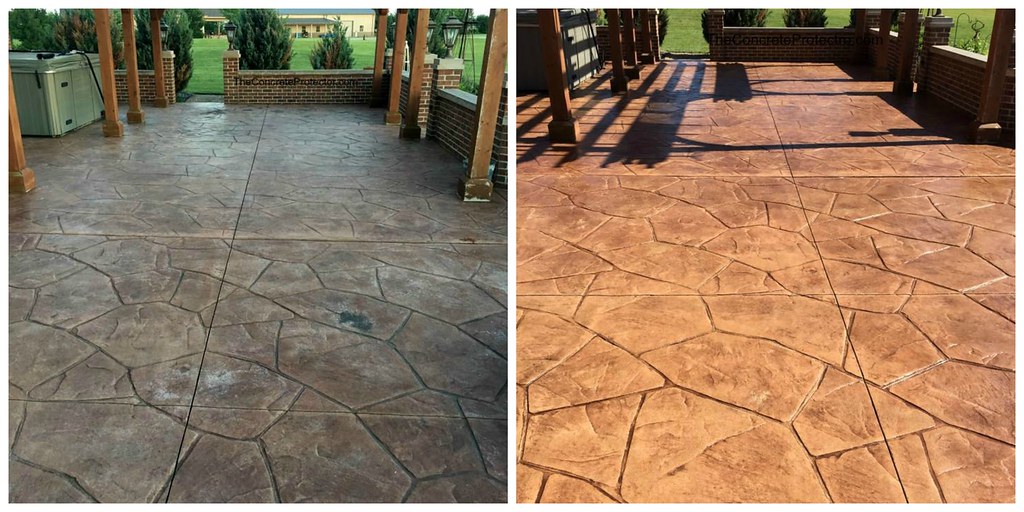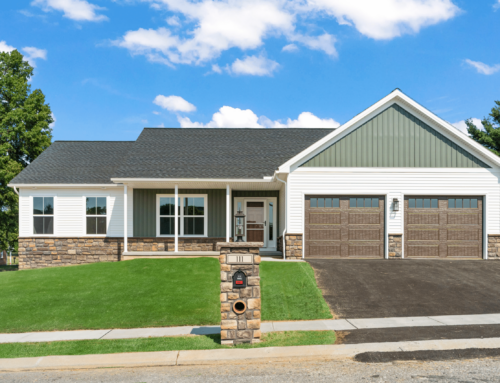By John Riha, who has written seven books on home improvement and hundreds of articles on home-related topics. He’s been a residential builder, the editorial director of the Black & Decker Home Improvement Library, and the executive editor of Better Homes and Gardens magazine.
Here’s everything you need to know about stamping concrete patios, including benefits, drawbacks, and costs.

That’s not all. Stamped concrete can mimic brick, cobblestones, cracked earth, and weathered wood. Add a bit of fun with leaf patterns, animal shapes, even dinosaur footprints.
Best of all, a stamped concrete patio is low-maintenance — the “stones” won’t settle over time, creating uneven surfaces, and there are no grout or joints that can open up to let grass and weeds sprout.
What’s a Stamped Concrete Patio?
A stamped concrete patio is simply a concrete slab with a textured, embossed surface. The contractor:
- Pours and smooths the slab.
- Presses a pattern into the surface while the concrete is still wet and soft.
- For realism, adds color to the concrete as it’s mixed, or sprays it on after the surface has been stamped.
Make sure you hire a contractor who’s done stamping, and has the examples to prove it. Check references.
What’s the Deal with the Stamps?
The patterns are made using large, flexible polyurethane stamps. The stamps are about 2-by-2-feet square and an inch or two thick, and they’re pressed into the wet concrete to create the textured finish.
A concrete contractor may step on the stamps to press them into the concrete or use a tamping tool. Before putting the stamp on the concrete, the contractor sprays the patterned side of the stamp with a release agent that prevents concrete from sticking to it.
Using a colored release agent accents cracks and grout lines, giving the finish an “antique” look that enhances realism.
One pattern usually is a set that includes several stamps, each one with varying textures and shapes, so the overall pattern isn’t repeated too frequently. Stamps also have interlocking tabs so any grout lines align perfectly.
What’s It Cost?
A stamped concrete patio costs $10-$15 per square foot, professionally installed. Here’s a quick price comparison:
- Plain concrete: $6-$12 per sq. ft.
- Brick: $14-$20 per sq. ft.
- Stone, slate, or marble: $17-$28 per sq. ft.
- Concrete pavers: $13-$20 per sq. ft.
Can I Do It Myself?
Making a stamped concrete patio is a fairly simple process, but only skilled DIYers should attempt it. That’s because concrete can be a tricky medium to work with:
- It requires a properly installed base of compacted sand and gravel.
- It’s heavy; you’ll need to be strong.
- Concrete requires specialty tools to shape and smooth the surface (any specialty tool performs best in the hands of an experienced worker who knows how to use it).
- Concrete sets up relatively quickly. Once it starts to harden, it’s difficult to apply the stamps.
- A mistake in concrete is permanent.
You can rent concrete stamps at rental outlets and concrete supply stores for about $25 per day per stamp. Doing your own work saves 20% to 50% of the cost of a professionally installed slab and stamped concrete finish.
Any Drawbacks to a Stamped Concrete Patio?
Very few:
- Deep depressions. Although stamped concrete is a good choice for ADA accessibility, be wary of deeply embossed patterns; all that texture may be tempting, but it creates uneven surfaces that make patio furniture wobble and may be hazardous for those with limited mobility. Accessibility guidelines require bumps and ridges on walking surfaces be no more than ¼-inch high.
- Fair-weather color. Although you’ll have more color options with surface colorants, the colorants may flake off over time. Have your concrete dyed while it’s being mixed for a more permanent solution.
- It’s got a ‘tell’. As good as stamped concrete may look, aficionados of real brick and stone will know the difference.
Can I Add a Stamped Finish to an Existing Patio Slab?
Yes, you can, as long as your old slab is stable and in good condition. You’ll be raising the height of the old slab by an inch or so, so you’ll want to make sure the new level doesn’t interfere with existing steps or vents in your foundation walls. The new concrete shouldn’t touch your siding, either.
A pro will prepare the existing slab by cleaning it and covering it with a bonding agent that ensures good adhesion between the old concrete and the new.
Then, your contractor will cover the old slab with new concrete, and apply the stamps.
Visit HouseLogic.com for more articles like this. Reprinted from HouseLogic.com with permission of the NATIONAL ASSOCIATION OF REALTORS®.











